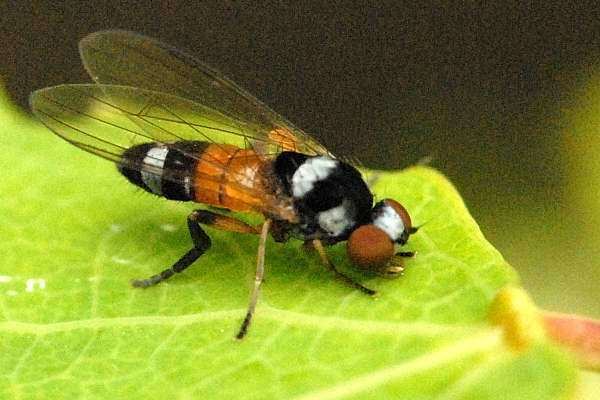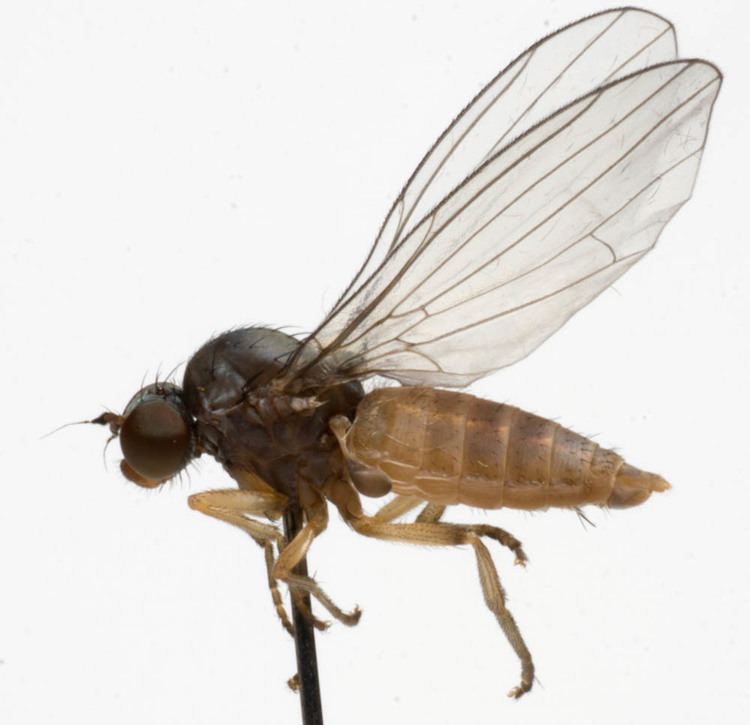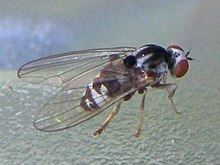Order Fly | Scientific name Platypezidae Rank Family | |
 | ||
Similar Fly, Lonchopteridae, Opetiidae, Scenopinidae, Clusiidae | ||
Lindneromyia dorsalis platypezidae
Platypezidae is a family of true flies of the superfamily Platypezoidea. The more than 250 species are found worldwide primarily in woodland habitats. A common name is flat-footed flies, but this is also used for the closely related Opetiidae which were included in the Platypezidae in former times.
Contents

Some other genera formerly included here have been recognized as quite more distant and are nowadays placed in the asilomorph family Atelestidae.

Description
For terms see Morphology of Diptera.
Platypezidae are minute to medium sized (1.5–6 mm) slender or robust flies. The male and female usually differ in colour. Males in particular are often all black, one or both sexes may be in part or all grey or yellow. Markings may be orange, grey or silver. The abdomen may have two colours. Males have holoptic eyes. The antenna has three segments, the third is the largest and bears a long, apical arista. The wing is clear or tinged (the area along the wing margin, around veins Sc and R1 is darkened in some genera).The wing has large anal lobe and the anal vein reaches the wing margin. The cell cup ends in an acute angle and is often elongate.Vein M is forked in most genera. The crossvein DM-Cu is present (absent in Microsania where crossvein R-M is also lacking). The legs are short and robust.The first tarsal segment is usually swollen in the male, slender in the female and the distal tarsal segments are cylindrical (the first tarsal segment of the hind leg is long and cylindrical in the subfamily Callomyiina). In the subfamily Platypezinae the first tarsal segment of the hind leg is shortand laterally compressed, the distal are tarsal segments are also laterally compressed, in particular in the female.

The larva has a poorly differentiated, fairly unsclerotized head with short tuberclelike antennae located above rudimentary palpi and 11 body segments.It is amphipneustic (having only the anterior and posterior pairs of spiracle). The form is usually flattened, but in some species cylindrical. Most species have lateral marginal processes, typically with one pair on each body segment, except for segments 2 and 11, which have more. Smaller dorsal processes are present on segments 3–10. Segments 3–10 often bear bristles, but bristles are not present on segments 1,2, and 11. The spiracles are located on the ends of wrinkled tube-like spiracular processes, the anterior pair (prothoracic spiracle) are on segment 1 the posterior ones are on segment 11 (anal segment) .
Biology

Members of the Platypezidae inhabit damp woodlands. Larvae are fungivores. Adult males form aerial swarms before mating using trees or bushes as swarm markers. Some species of Microsania Zetterstedt are attracted to wood smoke and wood ash. Adults may be found performing rapid erratic movements on broad leaves of both woody and herbaceous plants, evidently feeding on surface deposits.
Adults are seen either on the wing or running about in an erratic fashion on the leaves of bushes in partially sunlit, dappled shade.They hover in swarms of dancing males in forest openings. The females are attracted to chosen males in such swarms, where aerial coupling begins and the paired flies settle with heads in opposite directions on low bushes until mating is over. Feeding platypezids move rapidly over leaves, occasionally stopping to ingest honeydew or other food. The first feeding episode begins at midmorning, ceases at a time later in the morning then resumes in the afternoon. These times corresponds to the times of the day when insectivorous birds are least likely to feed.The mid day rest is when the sun is at a specific angle (peculiar to each species) and the afternoon feeding episode begins when the sun sinks to the angle that initiated the rest in the morning.
